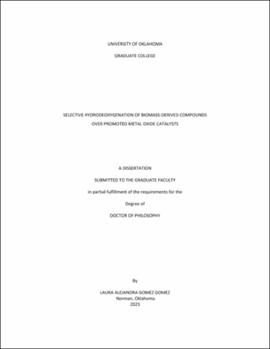| dc.description.abstract | The pressing need to address environmental issues has led to a growing demand for cleaner and sustainable energy sources, such as biomass. Lignocellulosic biomass-derived bio-oil offers great potential for producing renewable chemicals and fuels. However, the complex nature of this mixture, characterized by a high oxygen content, makes it unstable and undesirable. Therefore, catalytic upgrading is required to improve its properties and remove unwanted components. In this dissertation, the author will utilize various model compounds to investigate the deoxygenation of biomass on highly active reducible metal oxides like MoO3 and TiO2.
The first part of the dissertation focuses on investigating the selective activation of renewable carboxylic acids using promoted molybdenum oxide (MoO3) to form alcohols and aldehydes. This study used a combination of reaction kinetics, temperature programming reduction (TPR), and X-Ray photoelectron spectroscopy (XPS) to gain insights into the underlying mechanism. The findings suggest that the activity for HDO reaction scales with the concentration of Mo5+ species. Meanwhile, this study explores the effect of adding a small amount of Pt (0.05 wt%.) on the rate of selective deoxygenation. The outcomes demonstrate that adding Pt clusters results in a substantial decrease of 32 kJ/mol in activation energy required for the HDO reaction. Moreover, a kinetic study is performed to enlighten the understanding of the selective deoxygenation of carboxylic acid on promoted MoO3 at mild temperatures, indicating that incorporating Pt clusters over MoO3 shifts the reaction order with respect to hydrogen from 1 to 0.5 at a low partial pressure of pentanoic acid (PA). The inhibition effect of PA and its possible causes are discussed for both MoO3 and 0.05 wt% Pt/MoO3 catalysts.
Furthermore, the rapid dynamic changes in MoO3 upon reduction and under reaction conditions were also investigated. A catalytic kinetic model is developed for redox chemistry on MoO3, which considers the formation of hydrogen bronzes, phase transition, oxidation states, oxygen vacancies, hydrogen splitting and spillover, and oxygen mobility throughout the oxide. A micro-pulse reactor was employed to quantify the number of hydrogen bronzes and oxygen vacancies created after various pretreatments. The effect of hydrogen bronzes on MoO3 for the deoxygenation of pentanoic acid is also investigated.
In the second part of this dissertation, carbon nanotubes were utilized to investigate the location of the active sites involved in the three different chemistries, including furfural, pentanoic acid, and anisole conversion. This novel catalyst was synthesized by depositing two different metals on different ends of the nanotube to decouple if the active sites were created either by promotor effects or short-range interactions between the two components in the bifunctional catalyst system. In all cases, a rapid hydrogen spillover observed across the nanotubes from one metal to another is considered.
Through the end of this dissertation, the conversion of furfural to cyclopentanone is studied, focusing on the role of water, the active sites involved, and the reaction mechanism over various catalyst supports. The study reveals that the selectivity for ring rearrangement versus C-O cleavage over Ru and Pd catalysts supported on TiO2 can be adjusted by controlling the partial pressure of water. Additionally, the location of the active site and crucial kinetic pathways for this rearrangement reaction are discussed by utilizing the ability to synthesize carbon nanotubes with different properties. | en_US |
